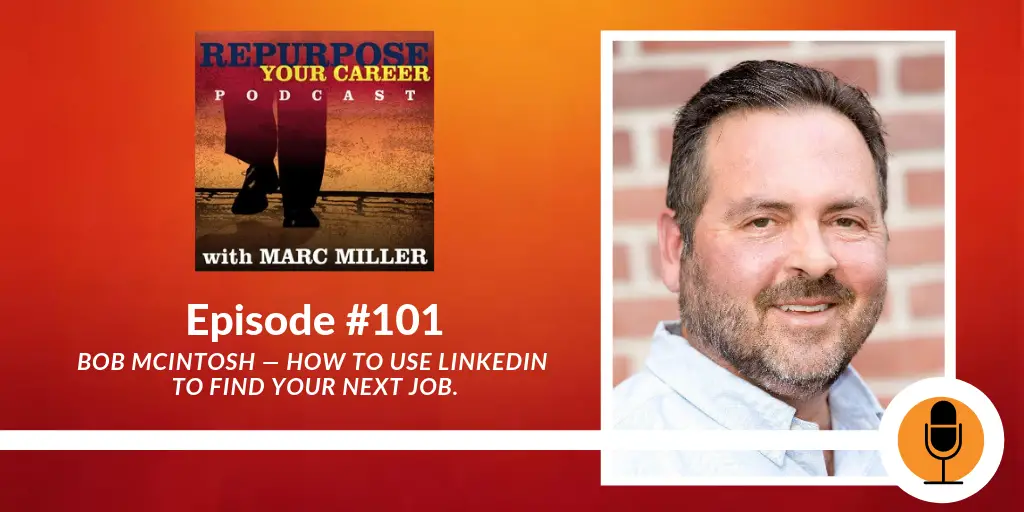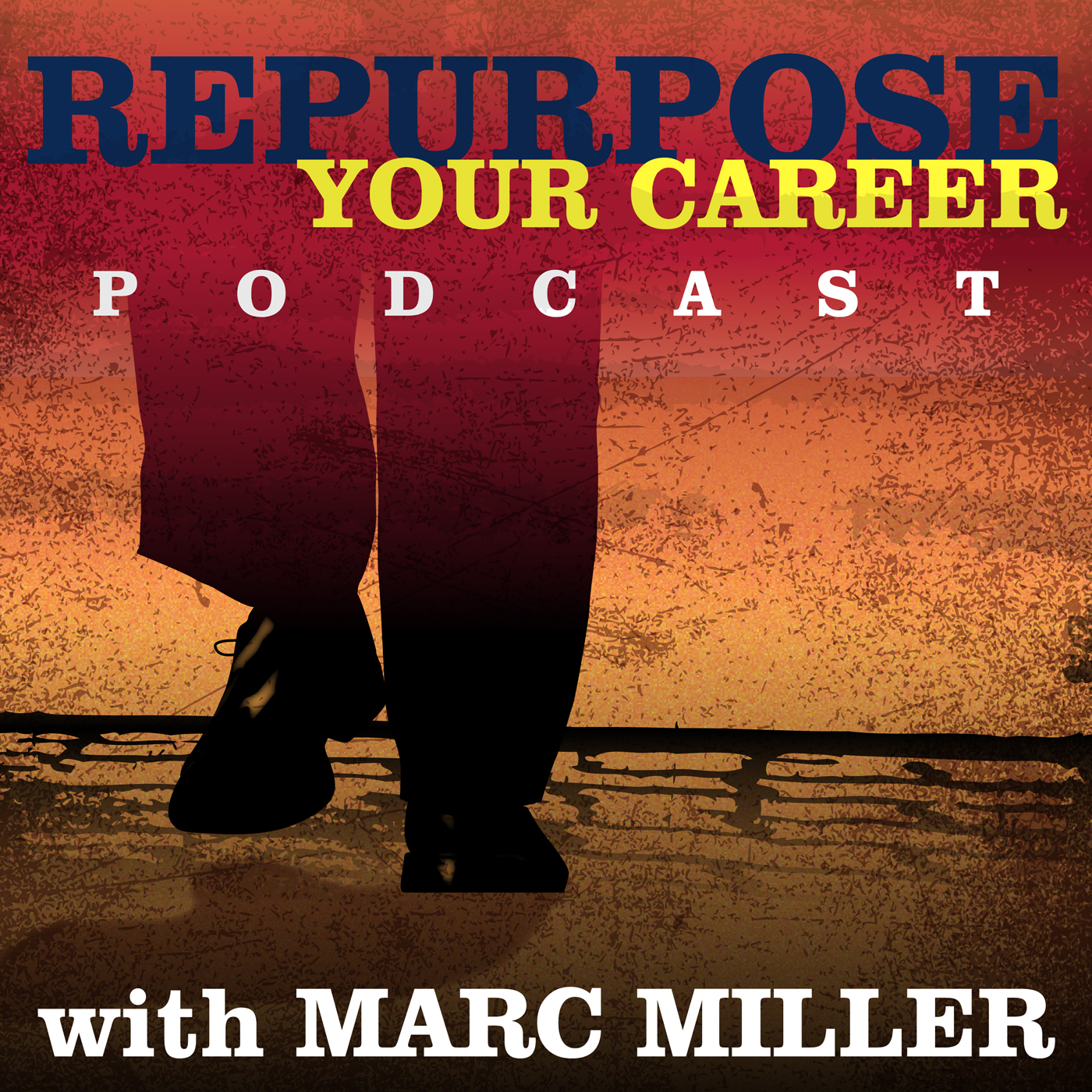Episode #101 – Marc interviews LinkedIn expert Bob McIntosh on applying LinkedIn to your job search.
Description
Bob McIntosh is a career trainer who leads more than 15 job search workshops at an urban career center. He also critiques LinkedIn profiles and conducts mock interviews. Bob started the first LinkedIn program at MassHire Lowell Career Center and created workshops to support the program. Jobseekers from across the state attend his LinkedIn workshops. Bob has gained the reputation as an authority on LinkedIn. Marc has known of Bob for many years, but they had never met. Marc heard Bob on an episode of Mark Anthony Dyson’s The Voice of Jobseekers Podcast and knew he had to have Bob on as a guest.
Key Takeaways:
[1:22] Marc welcomes you to Episode 101 of the Repurpose Your Career podcast.
[1:34] If you’re enjoying this podcast, Marc invites you to share this podcast with like-minded souls. Please subscribe on CareerPivot.com, iTunes, Google Play and the Google Podcasts app, Podbean, Overcast, TuneIn, Spotify, or Stitcher. Share it on social media, or tell your neighbors and colleagues so Marc can help more people.
[1:55] Next week, Marc will interview Michael O’Brien, who, like Marc, suffered from a near-fatal bicycle accident. Hear how this changed his life. Michael is the author of Shift: Creating Better Tomorrows: Winning at Work and in Life.
[2:14] This week, Marc interviews Bob McIntosh. Marc starts with Bob’s bio.
Now on to the podcast…


Marc Miller
RYC_101
Download Link | iTunes | Stitcher Radio | Google Podcast | Podbean | TuneIn | Overcast
[3:29] Bob leads workshops at an urban career center and counsels individuals one-on-one. The workshops range from resume writing to LinkedIn to salary negotiations. Bob is more of a job coach than simply a workshop facilitator.
[3:57] Bob developed the first LinkedIn workshop at the [then] Career Center of Lowell and since then, he has been updating workshops to meet the needs better of their clients. He finds great pleasure out of helping people find work.
[4:16] The average client age at the career center is about 55. What older workers need to realize is that between 87% and 94% of recruiters use LinkedIn to find talent. Employers want to know that candidates are tech savvy and use platforms like LinkedIn. Finally, LinkedIn is a great platform for landing a job through professional networking.
[5:29] To use LinkedIn, Twitter, and Facebook effectively says you are up-to-date. If you don’t use them, you are invisible. Bob has read that 40% of employers will disqualify you just for not being on LinkedIn.
[6:00] Bob says there are three components to a successful LinkedIn campaign, profile, networking with the right people, and being engaged on LinkedIn.
[6:27] It’s very important that LinkedIn users have a full profile with all of its sections completed. Bob lists the parts. It must include keywords relating to their occupation and areas of expertise that will make the profile searchable. Bob explains how to use them.
[7:24] Bob sees the profile as more of a personal resume than the resume itself. Bob says your resume can be in the first-person or third-person point of view. It’s a networking document, like sitting down and talking with an employer.
[7:57] Bob considers the uses of first-person vs. third-person point of view resumes. Most people use the first-person point of view.
[8:58] Try to have a tone on your profile that speaks personally, in first-person POV.
[9:04] Structure your LinkedIn networking with the right people. First, the people you work (or worked) with — supervisor and colleagues. Second, people who do the same type of work you do. Third, people in the same industry, with something in common with you. Then add people who do your kind of work in different industries.
[9:42] Try to connect with recruiters, in the same industry in which you are looking. Networking is a two-way street.
[10:18] For younger folks, focus on alumni and professors. LinkedIn’s See Alumni feature lets you see people who went to your alma mater.
[10:53] Bob recommends 500+ connections. 10K is not too many. The more connections you have, the more opportunities you’re going to have in terms of people reaching out to you and finding you.
[11:17] Once you have connected with people, every once in a while, ping them and let them know that you’re there.
[11:32] Marc suggests going through your connections once a week, picking two or three that you haven’t heard from in a while, and send them a “checking in” email. A significant number will respond.
[12:08] Bob suggests considering removing from your network people who don’t respond. It’s about communication.
[12:26] For your headshot: In 2003 it needed to be really professional. Things have gotten a little more informal. Aim for a headshot that reflects the sort of work you do. A banker would stay with a suit and tie. A job coach might wear a nice button shirt with a little bit “going on” in the background. No selfies.
[13:49] The background image needs to brand you. Does it reflect the kind of work that you do?
[14:14] Without a headshot your site is much less likely to be visited or seen. Know what message you are sending with your headshot and background image. Marc shares a couple of case studies from his jobs club. Your background image needs to explain who you are, what you do, and what you are trying to accomplish.
[17:43] Take that message into your summary and your experience section. What you are doing is showing value and branding yourself.
[17:54] Marc talks about the case of an obscure profession. He recommends finding people with their same degree and same graduating eras, and look at what they are doing.
[19:10] To find recruiters, type in the search area: recruiter, your industry, your location. That will give you a list of local recruiters in your industry. Vet them by their profiles. What is more difficult is to grab their attention. The invite you send them should show what your value is in your industry.
[20:53] Be nice to recruiters. Marc refers to the episode with Gary O’Neal. Gary is a recruiter for Austin HR (Now Asure Software). Recruiters are busy and may not always have time to respond back but you want to be a polite persistent pest with them.
[21:47] What job seekers need to understand is that recruiters are working for the clients which would be the companies. Endear yourself to them. The right type of recruiter can be of great help.
[22:08] Marc recommends sending a recruiter that has been very helpful to you a $5.00 Starbucks card, even if you didn’t get the job. Marc gives a client example.
[23:24] Engagement may be the most important step. It keeps you on your network’s radar. Bob gives some examples of how to engage. Don’t just ‘like’ what people share. Leave pertinent comments. Start conversations and keep them going.
[24:52] Marc gets a lot of spam comments on his website and he always hits the spam button. People who are just trying to get SEO off a post are not worth the connection. When people send Marc a blank LinkedIn invite, he accepts it and immediately sends back I accepted your connection. How did you find me?
[26:06] Marc gets 30 to 50 connection requests a week. He responds to them, 10 at a time. Bob’s thought is if you’re not even putting in the effort to send a personalized invite, why should we connect?
[26:56] Marc doesn’t connect from the mobile app because it is too easy to send a generic invite to “people you may know.” You can send a personalized invite, but it is easy to forget. Bob just did that yesterday, in error.
[28:01] Marc talks about folks in the CareerPivot online community doing remote job searches. He recommends them to curate material, share it, and tag specific individuals saying “You might be interested in this.” Share articles of value to your connections and be helpful.
[28:48] Bob notes that Mark Anthony Dyson is a great curator of information that he shares with his connections.
[29:05] Marc has four or five places where he looks for material. One of these is NextAvenue.org. There are many things there that are useful to his audience.
[29:47] Bob’s final advice: If you want to be on LinkedIn and you want to use it in your job search, then it’s going to take work. It’s not just simply setting up a profile, connecting with people, and then simply being active on LinkedIn. It’s going to entail all of what was talked about in this episode.
[30:35] Bob re-emphasizes, LinkedIn takes work. Put in the time to use LinkedIn successfully.
[31:06] Marc’s number one problem with his clients is getting them to put themselves out there. They want to write their LinkedIn profile and put it on auto-pilot. However, they must compete with people all over the world for jobs. Show what makes you different. This is especially important if you are a little older.
[31:41] It’s not bragging. Don’t promote yourself obnoxiously. Be factual. Be proud of what you’ve done but don’t brag. On the other hand, don’t just remain silent. You have to make a bold statement because you want people to go on and read the rest.
[32:53] Marc thanks Bob for being on the Repurpose Your Career podcast. People can get in touch with Bob at LinkedIn.com/in/BobMcIntosh. If you send an invite to Bob, please personalize it! When people don’t personalize an invite to Bob, it’s a very easy decision — it’s click “Ignore.”
[34:08] Marc hopes you enjoyed this episode, especially about activity vs. engagement. This takes work but it will pay off in spades in the future. You just need to work at it.
[35:39] Check back next week when Marc will interview Michael O’Brien, author of Shift: Creating Better Tomorrows: Winning at Work and in Life.
How to Find More About the Podcast and Subscribe
Make sure to check out the Career Pivot Community.
You can contact us here.
Marc invites you to connect with him on LinkedIn.com/in/mrmiller. Just include in the connection request that you listen to this podcast.
You can look for Career Pivot on Facebook, LinkedIn, or @CareerPivot on Twitter.
You can get updates on this podcast by clicking on the Get Career Pivot Insights button below.
You can also subscribe to the podcast on iTunes, Stitcher, Google Podcasts, Podbean, Overcast, Spotify, and Pandora.
The podcast is available on YouTube.
Please consider writing a review on Apple Podcast or on Podchaser.com.
Like What Your Read? Get Career Pivot Insights
Do You Need Help With ...
Check out our Help Center where you have access to 14 different content portals.

